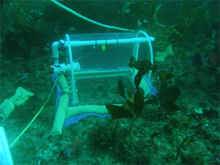
A rugged low power dissolved oxygen sensor
The D-Opto sensor – which measures temperature, dissolved oxygen saturation and dissolved oxygen content in liquids – is an indispensable tool for environmental monitoring and research.

Pictured is an example of a productivity chamber used in the Santa Barbara Coastal Long Term Ecological Research (SBCLTER Programme).Water is circulated through the closed system by the pump mounted on the side. The two ends are made of rigid Plexiglas, and the domed wall is flexible Teflon sheeting (Tefzel), to transmit wave energy (which also circulated water around the algae) inside the chamber. The edges are sealed to the substrate by a weighted plastic skirt.
Field proven solid state optical sensing technology makes the D-Opto very stable over extended periods of time, even in harsh conditions, and is ideal for remote environmental monitoring installations
- Copper bio-fouling control ring around the sensor window
- Low power consumption and low sensor drift make it ideal for remote battery and solar powered installations
- SDI-12 Output
- Rugged interface for simple, quick connection to the data logger
- Simultaneous connection with a computer to ease in-situ calibration and field checks
Accuracy
- Dissolved Oxygen; 1% of measurement or 0.02ppm (Whichever is greater)
- Temperature: +/- 0.1 Deg C
Resolution
- Do Saturation: 0.01%
- DO Content: 0.001 PPM
- Temperature: 0.01 Deg C
- Signal options: SDI – 12
- Output signals: DO%, PPM, Temperature, DEG C
Physical
- Size: 48mm diameter x 150mm long
- Depth rating: 30 metres
- Bio-fouling control: Copper guard around sensor window. Optional shutter system.
Power
- Power requirements: 8-24 volts DC
- 0.5mA between measurements, 20mA during measurement (plus 4-20A signal if relevant)
- Cable: Up to 100m. EPDM sheathed, fully screened
Software
- D-OptoCom, supplied at no charge
How it works
In contrast to conventional dissolved oxygen instruments, the D-Opto sensing element utilises fluorescence to measure dissolved oxygen.
The basic principle involves subjecting a fluorescing compound to a fixed wavelength of light. When the light source is removed, the compound emits a fluorescence, the intensity of which is dependent on the oxygen levels present in the surrounding water.
Ruthenium is used as the fluorescing compound in the D-Opto. An extremely stable electronic circuit is used to excite the ruthenium, and then measure the intensity of fluorescence. As a result, the D-Opto should provide accurate dissolved oxygen measurements over long periods of time without the need for re-calibration.
Unlike conventional polarographic dissolved oxygen sensors, the optical method does not consume oxygen. Consequently the measurement of dissolved oxygen by the D-Opto is unaffected by water flow. Similarly the D-Opto does not utilise a membrane or any other consumables, thus minimising the servicing requirements.
Ordering Information
D-01 D-Opto sensor (please specify cable length) includes;
Sensor, bio-foul ring, interface board, software, and communications cable.
